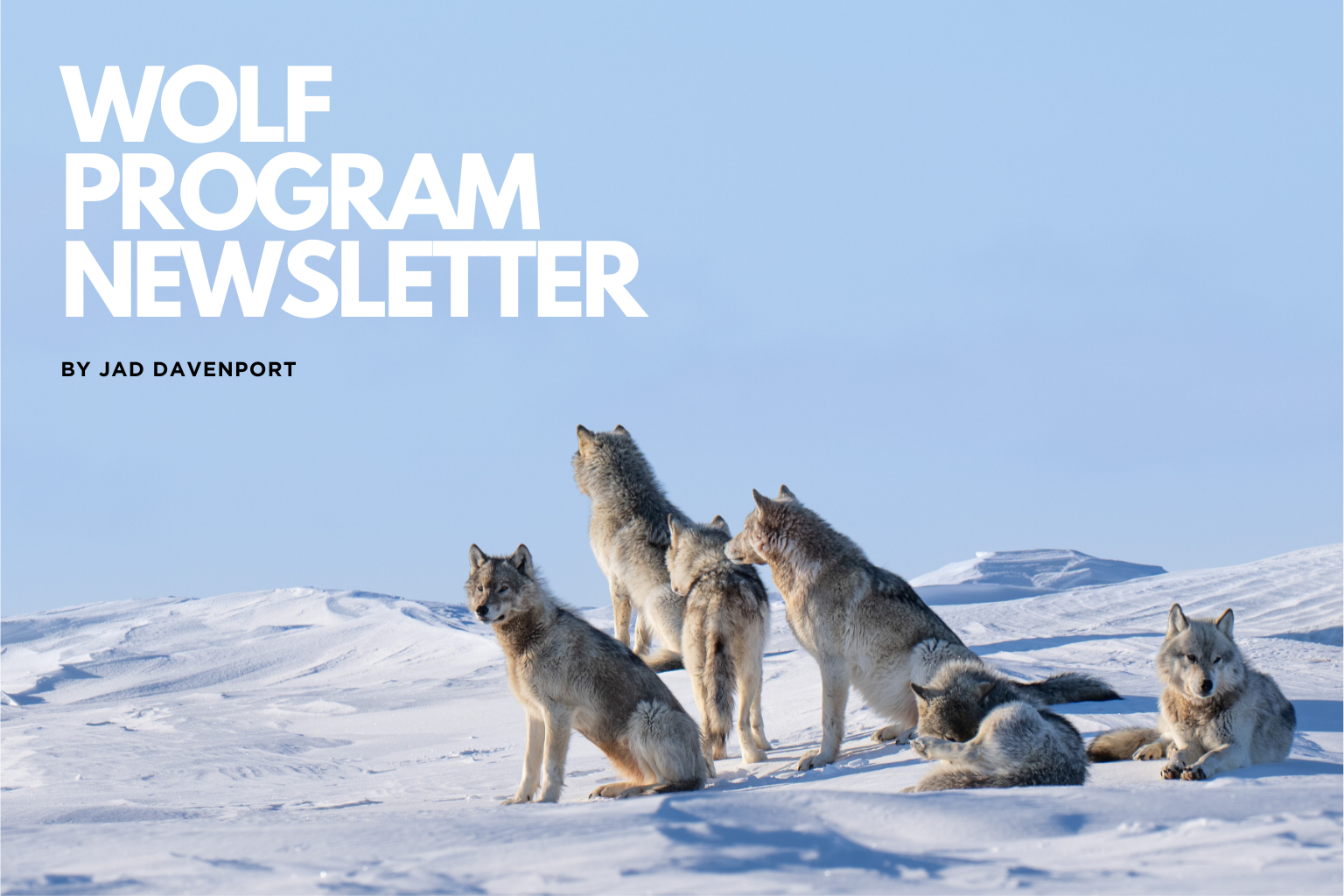
Written by Jad Davenport | National Geographic Photographer
Instagram: @jaddavenport
FIRST EDITION
Welcome to the first edition of Churchill Wild’s Wolf Programs Newsletter where we will provide quarterly updates on how the Opoyastin Pack is doing at our Nanuk Polar Bear Lodge! So far in 2023 we have welcomed guests on two February/March expeditions which boasted some of our best wolf encounters to date. The expeditions were able to investigate three moose kills, a potential otter kill, and observe and record the pack hunting, feeding, playing and resting.
We’re looking forward to having our third and fourth expedition members join us this November/December. Our plans are to observe and document how this year’s litter is surviving and integrating into the Opoyastin Pack, and search for evidence of additional packs.
OPOYASTIN PACK
Wolf packs are traditionally named after prominent geographic features in their territory although there have been some notable exceptions—including the Lightfoot Pack in Minnesota’s Voyageurs National Park. That pack was named to honor Canadian singer/songwriter Gordon Lightfoot.
Following tradition, however, the pack whose territory includes Nanuk Polar Bear Lodge is named after the Opoyastin River; the lodge sits on an island in the delta.
According to York Landing Elder and Churchill Wild guide Butch Saunders, the name, Opoyastin is Swampy Cree for ‘big wind.’ Butch says that the Swampy Cree named the river after a powerful wind blew down trees along the river.
One other pack of six wolves has been spotted from the air to the northwest of the lodge in Wapusk National Park. The Owl River Pack, an all-white pack, has been seen several times along the banks of its namesake river.
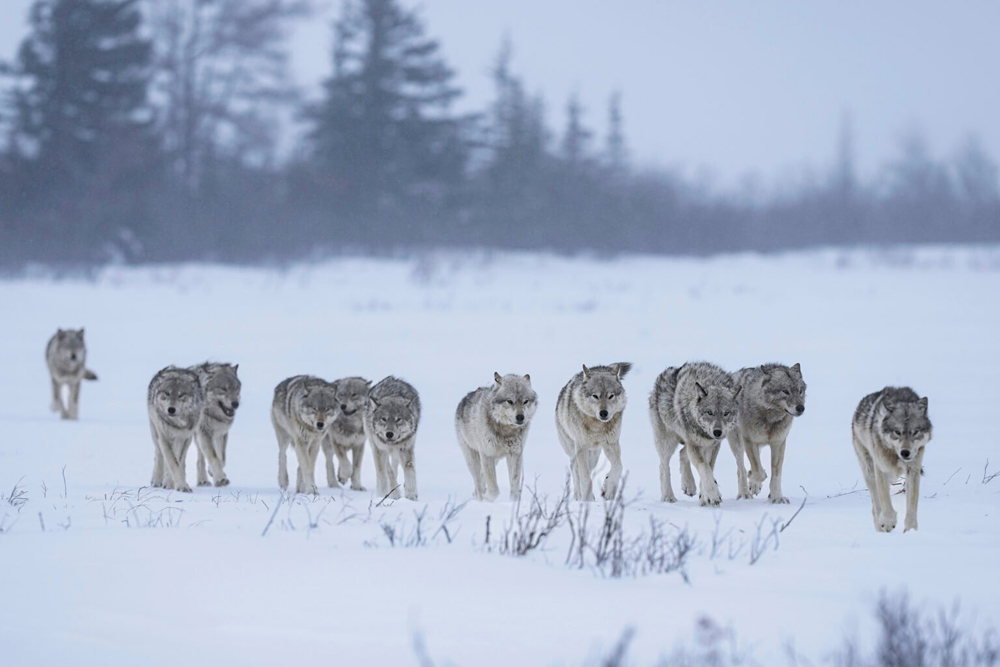
Photo by Christoph and Fabienne Jansen
PACK SIZE
When we last left the wolves in December 2022, there were 17 individuals. Our spring expeditions had a confirmed count of 13 wolves traveling as a pack, with one additional possible.
It is not uncommon for wolf packs to change size each year as new pups are born, older siblings drift off to join new packs or create their own, and older wolves die or are killed while hunting. The leading cause of mortality in wild, unexploited wolf packs is interpack violence.
The spring expeditions witnessed several matings in mid-March. Subsequently a new litter of wolf pups were born in May. As of August there were six pups from the May 2023 litter and a total of 16 wolves. The average litter size for wolves is between four and six.
COMPOSITION OF THE PACK
It’s a common myth that wolf pack structure is based on a hierarchy achieved through conflict, the constant battling of individuals for the right to mate and lead the pack.
This myth emerged in the 1940s when animal behaviorist Rudolph Schenkel published a paper about his studies of wolf pack structure. In the 1930s Schenkel had observed captive wolves (often nonrelated) that were kept together in enclosures. Based on the fierce fighting, the displays of dominance and submissiveness he decided wolves were a power-based society. It was akin to studying prison yards to write a paper on suburban family structure.
Today we know that a wolf pack is simply a family unit. It can be composed of nothing more than a male and female traveling together with no pups, to a breeding male and breeding female and their offspring. Sometimes packs will include unrelated wolves that have joined them.
This is why we have replaced the outdated terms ‘alpha male’ and ‘alpha female’ with ‘breeding male’ and ‘breeding female,’— some biologists simply say ‘mom’ and ‘dad.’
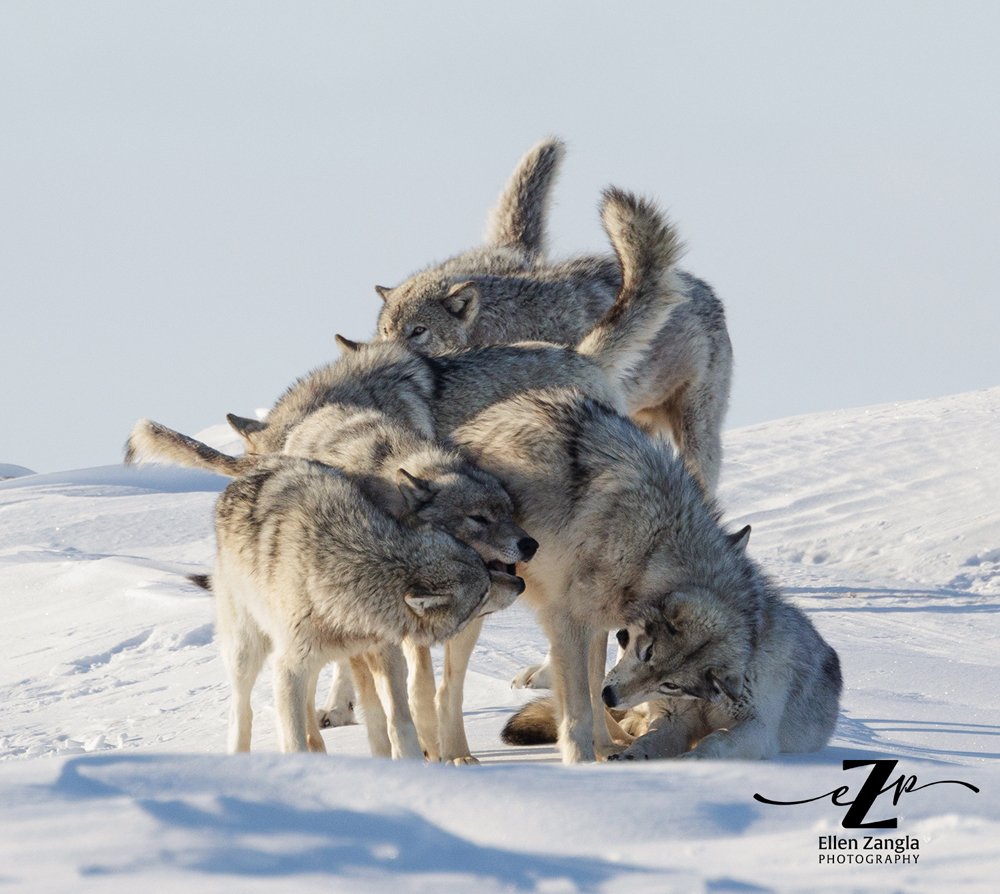
Photo by Ellen Zangla
PACK TERRITORY
Wolf territories is land that a pack regularly marks and defends from other wolves.
Wolves make their living on their long legs and are in perpetual motion, especially during the winter when the pups are old enough to travel and hunt with the pack. Our pack is no exception. It’s nothing for them to travel 70 km in 24 hours, especially if they are moving along our packed snow machine trails.
Our study is noninvasive, meaning we will not radio or gps-collar any of the wolves. While this limits our efforts to define exact territories, we are able, through our snow tracking and observations in the winter, to get a rough outline of the Opoyastin Pack territory.
Our study so far has shown this pack patrols a coastal territory at least 104 km in length, extending from the York Landing Ten Shilling Creek moose camp near the confluence of the York and Nelson Rivers to the west of the lodge all the way out to the tip of Cape Tatnam and possibly much farther. We don’t yet know how deep they penetrate into the interior forest during the winter and summer or how far out on the sea ice they roam in winter.
OBSERVATIONS ON THE WOLVES TRAVELING
The wolves create vast networks of trails—sort of canine highways—through the deep snow, and they reuse these trails over and over throughout the winter. During our expeditions we have been able to use a drone to watch and record wolves as they travel along the network of trails they have created and utilize.
We’ve been observing and recording the wolves as they travel by using a UAV (unmanned aerial vehicle—more commonly known as a drone).
We’ve noticed that as the wolves travel on their own single tracks, they tend to bunch up nose-to-tail when the trails curve through thick trees (think of car traffic) and then spread out when the terrain opens up again.
While wolves are well-designed for deep snow travel with their narrow chests, long legs and massive paws, they still are diligent about conserving energy. Over time as they patrol and hunt their territory they will pack down these established trails and use them over and over again, often avoiding seeming shortcuts to take a longer, but more established, route.
Do the oldest and weakest wolves lead the pack? There’s been a lot of debate among wolf researchers on who leads the pack when it travels.
Our observations with the Opoyastin Pack show that it’s usually the breeding female that gets up from a nap first, stretches and initiates a direction of travel, with her mate right behind, followed immediately by this years’ pups. Last are usually the yearlings which seem a bit more independent.
Once the pack gets moving in a direction set by mom then often the youngest pups seem to love to charge up and down the line, chasing and tackling one another.
WOLF COLORATION
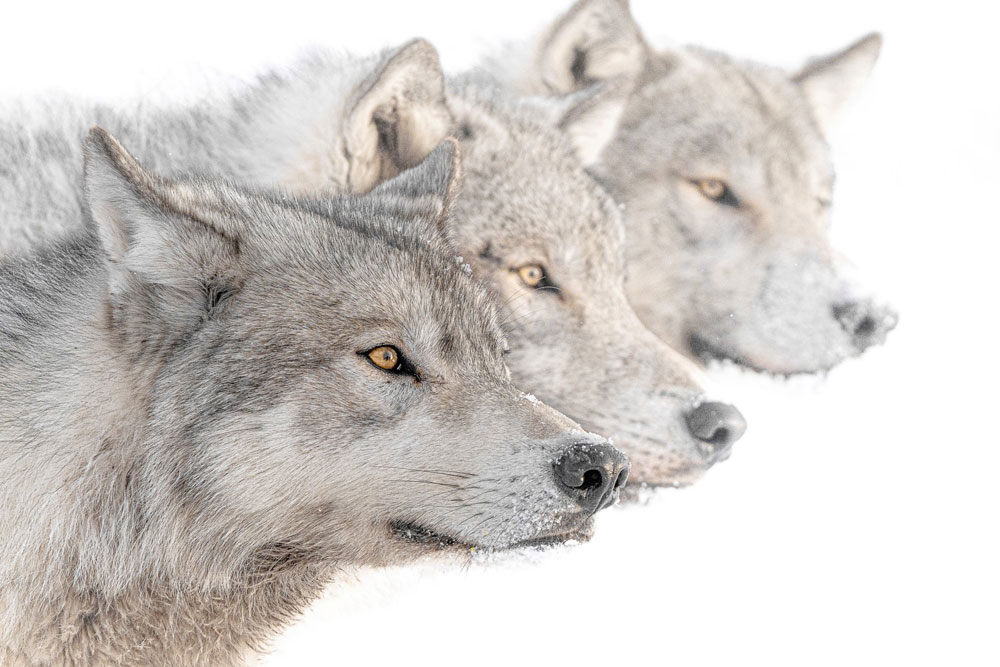
Photo by Jad Davenport
Our wolf pack right now are all gray. Traditionally, wolves with pure wild genetics range from the snow-white wolves of the high Arctic to the gray rain-cloud wolves of the Great Lakes and the Rocky Mountains. The gray wolf even has a reddish phase (some biologists claim it’s a separate species called the red wolf—that’s a whole political and biological quagmire) in the American southeast.
But black wolves are a breed apart. Literally. The quick version is that the black gene infiltrated North American wolves over 7,000 years ago somewhere in what is now Alaska and the Yukon. Researchers believe it comes from domestic black-coated dogs that crossed over with humans from Asia and interbred with wild wolves.
Interestingly, some researchers have noted that black wolves seem to have stronger immune systems than other shades.
We’ve had a number of black wolves in our study area. They are visually striking and ours have had beautiful butter-colored chest blazes. As they aged they developed handsome silver muzzles and eyebrows and looked quite regal. Over the last two years north and west of us we’ve seen a pack of six white wolves along the Owl River. They’ve been in Wapusk National Park but are much closer to settlements and therefore at higher risk from hunters and trappers.
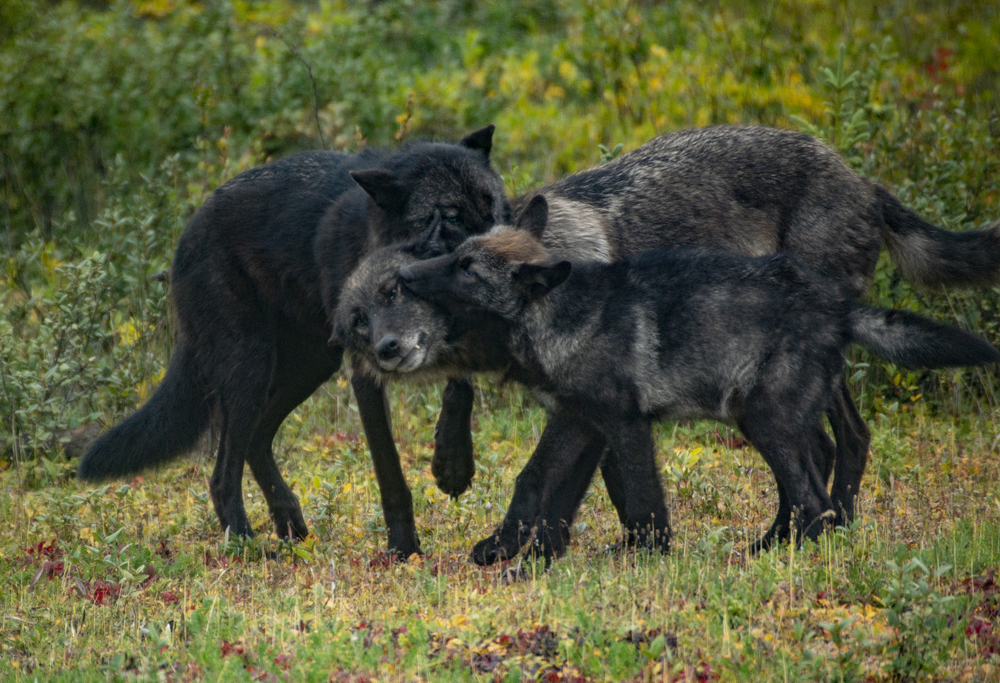 WOLVES PLAYING
WOLVES PLAYING
We found several wolf ‘toys,’ along the trail. While wolf dens are almost always strewn with toys like antlers, feathers, beaver feet and favorite sticks, it’s rarer to find wolves playing with toys beyond the homesite.
At a double moose-kill, however, we found evidence where the wolves had left their main trail and veered over to a small marsh where cattails (Typha latifolia) with full catkins (the fluffy seeds) still intact poked above a snow drift. The wolves had bitten off several of the catkins. From the tracks it appeared they had then played with the catkins in big spiral circle until finally running down the trail. Several of the stalks were carried 200 meters from their origin, with fluff distributed throughout.
Why would wolves burn precious calories at what appears to be play? In addition to keeping wolves in great aerobic shape and honing their hunting skills, play acts as a social pressure valve, allowing wolves to sort out their relationships without violence. Play not only allows more aggressive wolves the opportunity to assert themselves among their siblings but gives their siblings the chance to develop counter strategies. It creates a sort of detente.
AUDIO OBSERVATIONS
Many aspects of howling remain a mystery to researchers, but most agree that a primary function is to announce and defend territory from other packs. If you’re a wolf you can scent mark (pee, poop, scratch) all you want—and wolves do so in their home territories—but scent marking is only effective at close range. In this boreal forest and coastal tundra the Opoyastin Pack’s howls easily travel for many km along the coast, a warning to surrounding packs and any interlopers that this land is claimed and will be defended.
Wolves howl for many reasons. We’ve watched mom kick off a howling fest when she wants to get the pack moving after waking up from a nap; we’ve seen pups outside a den howl so hard they fell over backwards—and go on to do this over and over as they discover their voices; we’ve seen an injured wolf—left behind for several days while the pack hunted—give mournful howls, perhaps out of loneliness and wanting to know where the pack was.
In the past we’ve had numerous sightings of the wolves howling, especially young wolves separated from the pack. From a howling in pathetic little choruses and then wiggling excitedly when the pack says, “we’re over here;” we’ve watched the pack burst into howls (and chase) as a red fox stumbled into their midst (it escaped); we’ve watched wolves howl in what we think is purely a way to mark territory.
Howling, of course, isn’t the only way wolves communicate. Study participants spent quite a bit of time within several meters of the wolf pack and were able to hear lots of whining. Just like your dog, wolves whine for a variety of reasons, from excitement to fear. Pups are most likely whining because they are anxious to know where the pack is about to go and want to make sure they’re part of the plan (they always are). The pups frequently whined and pawed at their mother, making sure she heard them. Wolves’ hearing is extremely sensitive—they can hear sounds up to 16 km away if the wind is right.
FRESH MOOSE KILLS
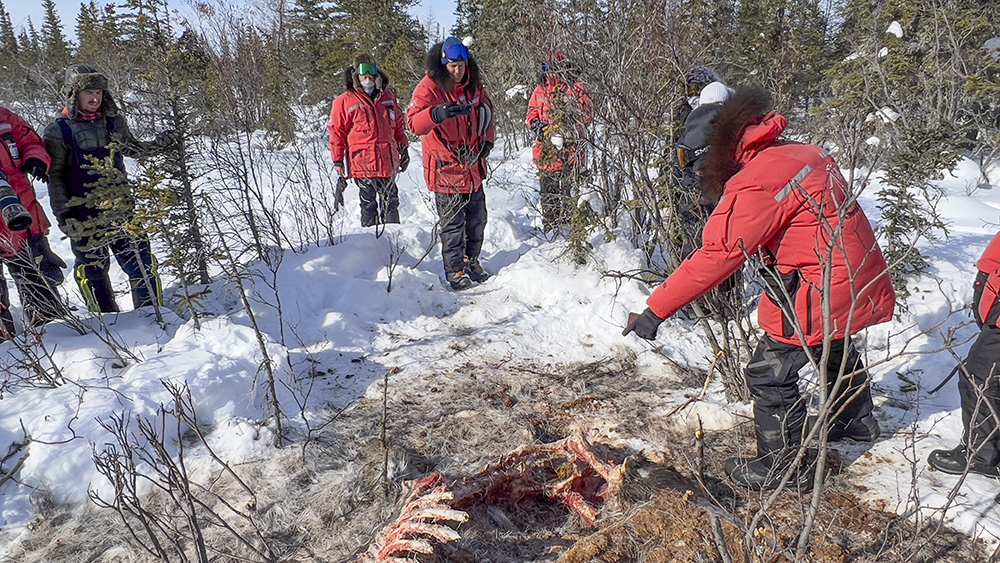
Photo by Jad Davenport
We were fortunate this year to find three fresh moose kills, all west of the lodge. On our past expeditions we’ve only discovered one moose kill which was to the east. The wolves were observed feeding on all the moose kills.
Generally a first feeding involves the breeding pair (if they aren’t too exhausted from the hunt) opening up the carcass and removing and consuming the heart, lungs and liver (these organs are rich in nutrients).
After a first feeding the wolves usually take a 6-10 hour break before returning for a second feeding. On the first feeding wolves will consume about 10 kg in about 15 minutes. By the time they do a second feeding, this consumption rate drops almost in half, to around 6 kg per wolf.
With a small moose, the pack could finish it off down to a spinal column, pelvic girdle and hooves in less than 12 hours. People unfamiliar with wolves will often see carcasses and think they’re several days or weeks old, when in fact they’re brand new. For the wolves, it’s often a race against the freeze and scavengers (ravens alone can remove 40 kg a day from a carcass).
One of the moose kills was a double kill. The wolves had taken down a cow and her calf. We were able to get trail cameras up on both kills and observe a variety of wildlife feeding on the remains including a marten, a wolverine and Canadian gray jays.
WILDLIFE OBSERVED

Photo by Jad Davenport
We are always recording all species of wildlife seen during our expeditions. Wildlife seen in the spring including a mother polar bear and two cubs, moose, red foxes, snowy owls, willow ptarmigan, American ravens and Canadian gray jays.
We also observed tracks from fisher and marten, North American river otters, snowshoe hares, lemmings and ermine.
WOLF TRACKING
Photo by Jad Davenport
What clues can wolf tracks reveal? Freshness? Direction of travel? Gait (walk, trot, lope, gallop)? Sex? Age of animal? What it was doing (hunting, marking territory, fleeing danger)? Was it a member of the pack or an interloper? Was it looking left or right? Was it injured or healthy? Was it one of the breeding pair(s) or a pup? Had it just made a kill or fed on a kill?
A good tracker will find clues to all of the above and more.
Study participants worked hard at learning how to track wolves (and other wildlife). In the winter, tracking gives us the most information on when and where wolves are, what they are doing and how large their territory is.
As an example, guests learned the following about this pee-mark:
– The linear urine streak and rear footprints far behind the mark tells us this is a male wolf.
– The fact that it was a standing urination in the center of the trail and not a raised-leg urination off to the side tells us this is not the breeding male (who likes to make a conspicuous splash on the snow banks on the side of the trails and at trail junctions to mark territory) but one of the subordinate males who just really, really needed to go.
– Because the mark was near other pack territorial marks (scat and paw scratching for scent marking) we’re confident this wolf belongs to the Opoyastin Pack and was not a transient passing through (wolves outside their home territories try to be discrete when urinating and defecating since it’s dangerous to advertise their presence behind enemy lines).
For guests joining us on future expeditions, a wonderful way to get good at wolf tracking is to follow your own (or a friend’s) dog in the snow. Observe how their tracks change as they go from walking to loping to galloping. See if you can tell which is the front paw and which is the rear. Don’t be fooled by the relationship between the tracks—by which one looks ‘first.’ Wolves, like most four-legged mammals, have to support the body mass of their head, neck, chest cavity and shoulders over their front legs while the rear legs only have to support the back half of the belly, rump and tail (much lighter). Because of this ‘weight-loading differential’ a wolf’s forepaws are slightly larger (and often more splayed—wider) than the rear paws.
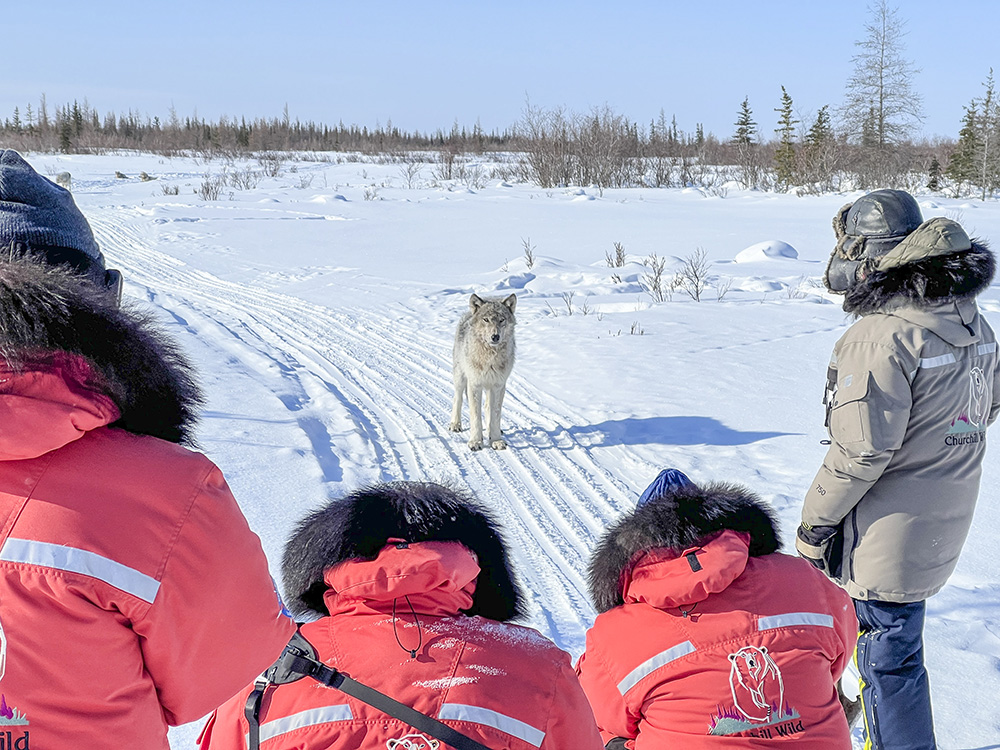
Photo by Jad Davenport
RECOVERED WOLF
We were excited to see a female wolf we’d observed with an injury in November 2022. She had what veterinarians call a degloving wound, where the flesh and skin over her radius—front bone on her forearm right above her wrist—had been cut and peeled down. We didn’t see it happen. It’s possible she was injured in a fight, but those kinds of injuries are almost always punctures with little damage visible on the exterior. It’s possible it was part of an old wound she reopened. A moose kick could be a possibility, but again unlikely, moose kicks are usually to the jaws and ribs and tend to be crushing injuries.
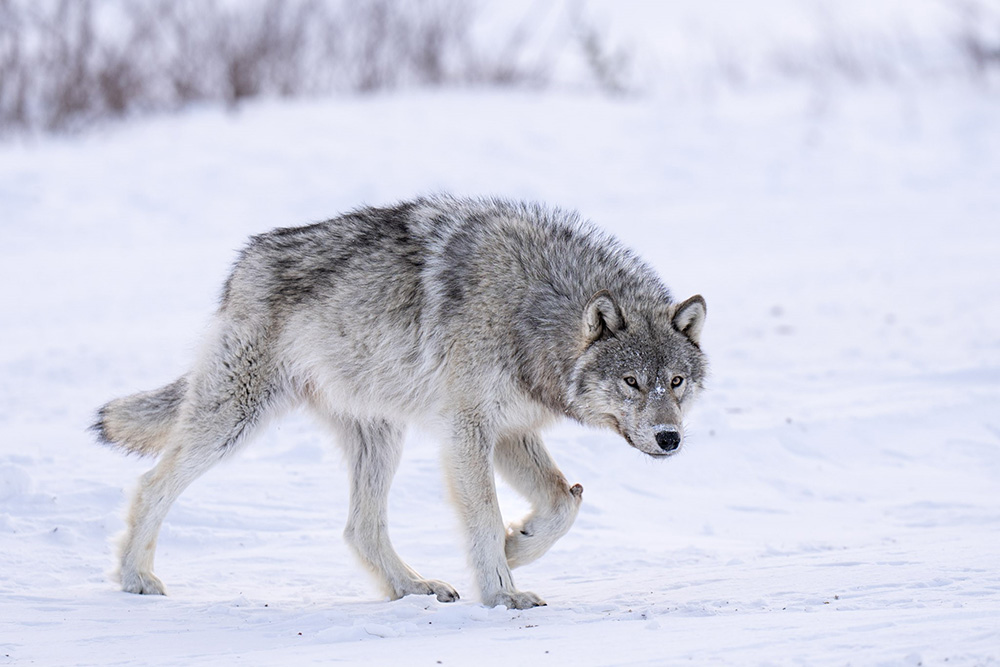
Photo by Christoph and Fabienne Jansen
Several vets and wolf biologists took a look at the injury and, without context, they all said ‘snare injury.’ We’re not aware of anyone trapping these wolves this year, but this coast was one of the most heavily trapped areas in Canada; it’s very possible there are forgotten snares still out there.
Regardless of how she was injured and even though her injury is still visible, she survived the winter and is back with the pack!
MOTHER BEAR AND CUBS
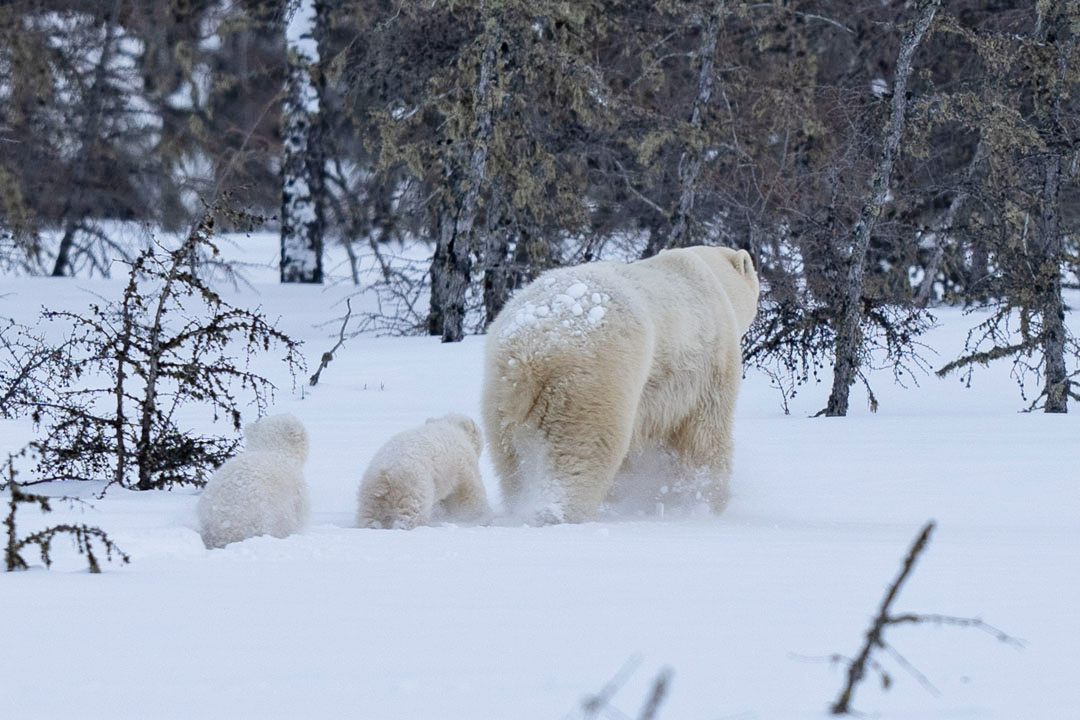
Photo by Fabienne Jansen
One of our most fortunate encounters didn’t directly involve the wolves. On the first expedition’s arrival guides were able to take us out to where a sow polar bear and her two three-month-old cubs were bedded down in a stand of black spruce east of the lodge. Guides and guests from the outbound Den Emergence Quest had been tracking the mother and cubs for several days. We were able to spend several hours watching as the sow slept and the cubs played and slept.
The wilderness along the Hudson Bay has the highest concentration of polar bear dens on the planet. The cubs are born right around New Year’s and spend about 80 days hunkered down in a forest den with mom. When she feels they are strong enough she begins leading them toward the coast, toward her favorite food—seals. But it’s a dangerous journey for mom and cubs, they run a gauntlet of wolf packs patrolling the coast looking for food. Our wolf study area is the only place where polar bears have been observed tracking and predating on polar bears (primarily cubs).
We went back to check on the bears the following day and were able to follow their tracks. The tracks were at a walking gait, and made their way out onto the sea ice where she would most likely be beyond the interest and range of the wolves. We did, however, spot wolf tracks over her tracks, though they appeared to have been made long after she passed through.
SOLO WOLF
A lone wolf was spotted east of the lodge sleeping curled up just off the skidoo trail. Our group stopped and photographed the wolf and spent an hour waiting to see if it would move. We eventually made the decision to leave the wolf sleeping and carry on. We noted that there was no evidence of tracks from the pack in the area, only this lone wolf. The fact that the wolf was sleeping just off the trail and did not seem wary led us to believe that the wolf was a part of the Opoyastin Pack. An intruder passing through their territory would normally sleep out of sight.
SAND DUNE ENCOUNTER
The Opoyastin Pack had spent most of the day sleeping out on the frozen sand dunes along the shore of the Hudson Bay. They’d recently made a kill (a cow and calf moose) and had eaten so much that some of them weren’t able to sleep curled up, and instead had to lie stretched out on their sides.
We made our way on foot over to the pack until we were within 40 meters. The wolves were bloody from their kill and often rolled around in the snow to wash the blood off their coats.
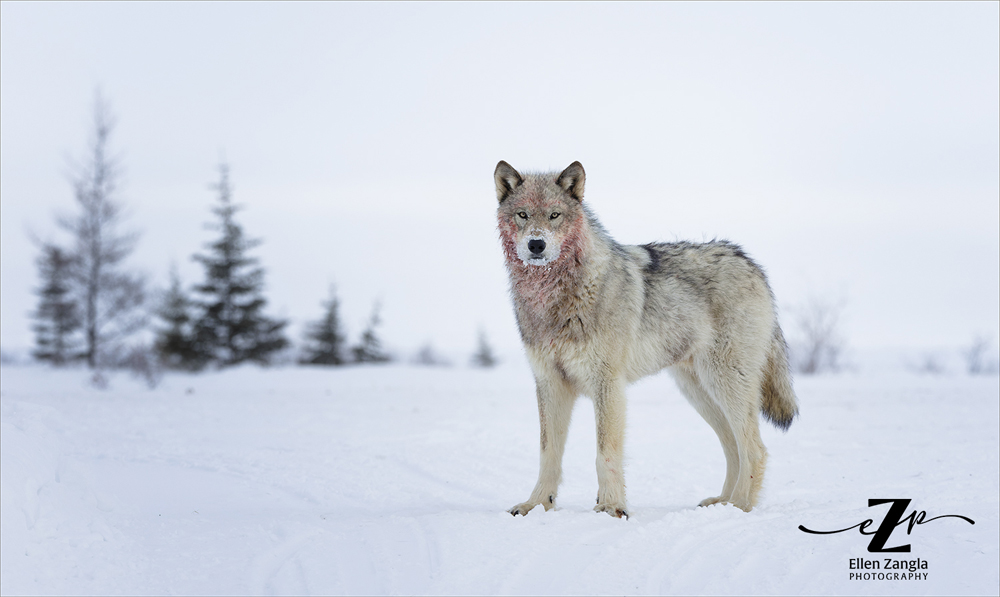
Photo by Ellen Zangla
We watched the wolves for most of the day, but all they did was sleep. Then, at about six, the pack began to stir. First the breeding female got up and shifted positions. Then the pups from this year got up and wiggled and wagged their tails and greeted her with obnoxious submissiveness. Soon the whole pack was up. Two of them broke away and trotted over to us, eventually followed by most of the pack.
For the next nine minutes the pack circled around us, sniffing and looking at us. Curiosity satisfied, they trotted off and into the trees.
RIVER OTTER KILL
During both expeditions we encountered numerous sets of North American river otter (Lontra canadensis) tracks to the west of the lodge. Often these tracks cut through open meadow for several hundred meters and skirted along the banks of rivers and creeks.
On March 18 we discovered the frozen carcass of river otter on the Mistikokan River. The tracks indicated the otter was had emerged from a shelf of river ice and was traveling north along the edge of the willow line on the west side of the creek. The tracks indicated the otter would explore the river bank, perhaps looking for another entry into the water.

Photo by Jad Davenport
After 50 meters the otter tracks collided with tracks from the wolf pack coming southbound along the river. A few meters from where the tracks ran into one another we discovered blood spatter and then a dead otter. The otter, an adult roughly a meter long, was laying on its stomach.
The otter had fresh blood around and in its mouth possibly aspirated during the apparent attack. It’s also possible the otter had bitten one or more wolves. The otter had a 3 cm tear at its throat and a second 2 cm tear in its abdomen with some post-mortem chewing on the tail. Other than the trauma that appears to have come from an attack, the otter seemed to have been healthy with a clean coat and good teeth.
We were curious to note the otter had not been eaten. In recreating the scene of the attack we were able to find two separate locations about ten meters from the otter’s final location that showed evidence of a struggle—wolf and otter tracks and blood spatter.
Sign at the kill seems to indicate this was a chance encounter. An otter traveling northbound along the river happened to run into the wolf pack which was headed southbound. A chase ensued. The wolves attacked the otter in two locations and then either killed it or moved its body to the third and final location. At the time of the attack, the wolves had been feeding on an active moose kill several kilometers to the west. It’s possible that the wolves were already full from eating and therefore did not consume the otter right away. It’s also possible that the otter was killed by younger wolves as part of play hunting.
We photographed the otter and left it in the same location, installing a trail camera so we could film additional encounters. On a subsequent visit the camera had been destroyed and the memory card removed by wolves. The otter was gone, but there were wolverine tracks showing drag marks leaving the area. It’s possible that a wolverine removed the otter from the wolf trail in an effort to cache and consume it. A wolverine was filmed by our trail cameras on the nearby moose kill.
There is very little information about the relationship between wolves and river otters. In the February 2018 edition of the Canadian Field Naturalist, an account of a wolf-killed river otter was recorded by Thomas D. Gable, Steve K. Winders and Ian C. Rautio. In this paper they noted accounts of wolves killing sympatric (occurring in the same geographic area) mustelids and other small predators. They found a river otter carcass on the ice of Rainy Lake in Voyageurs National Park, Minnesota. Like our otter, their otter was frozen and had not been consumed.
Similar to our find, the authors noted the otter had been encountered and killed in less than 15 meters. They, however, noted no blood in the area. Also similar to our find, the wolves on Rainy Lake had another kill nearby, in this case a White-tailed deer (Odocoileus Virginians) less than 1.5 km from the otter. Most of the deer carcass (like the moose in our area) had already been consumed.
A field necropsy of their otter revealed two 1 cm holes on the back right leg and severe trauma on the right side of the abdomen and rib cage (several ribs were crushed). Parts of the cranium had also been crushed. They concluded the otter died of blunt force trauma.
Also in Voyageurs National Park, in 1991 a wolf killed and partly consumed a radio-collared river otter. Despite these two accounts and the abundance of both river otters and wolves in the national park, a diet study of more than 4,000 wolf scats found no otter fur.
The only other published account of wolves killing a river otter comes from Milt Stenlund, a wildlife biologist with the Minnesota Department of Conservation. In his 1955 A Field Study of the Timber Wolf (Canis Lupus) on the Superior National Forest, Minnesota, he mentions encountering wolf-killed river otters during the winter.
GUEST PROFILE ABBY JENSEN
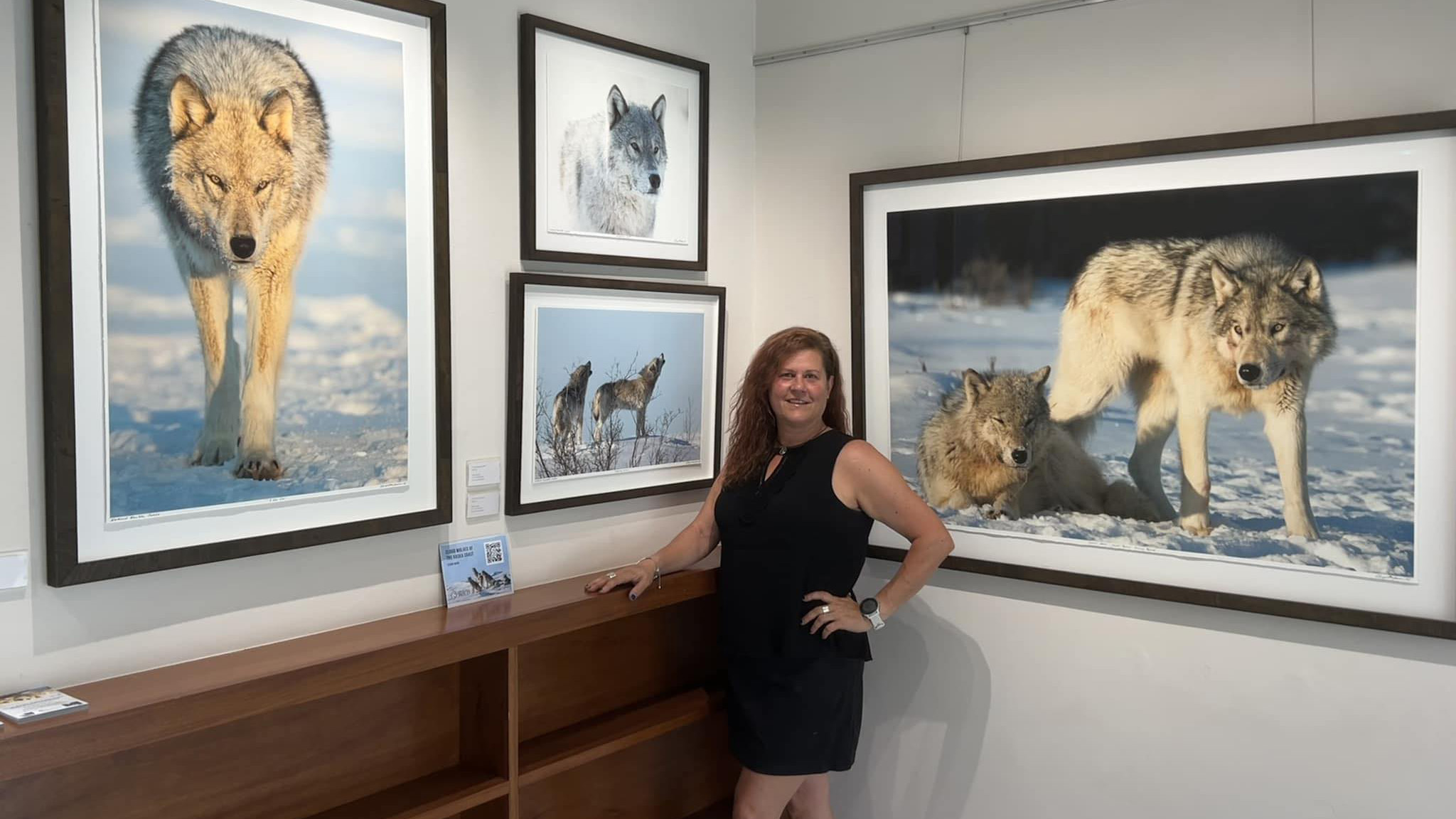
Abby Jensen
Abby Jensen is a Colorado-based wildlife photographer. She is part owner of the Pine Moon Fine Gallery and recently had an exhibition of her wolf photography from her March expedition. You can see her work at: https://www.jensen-photography.com
WHAT INSPIRED YOU TO COME ON A WOLF EXPEDITION?
Wolves have always fascinated me. Beautiful, social, family structured, hunting machines. And despite humanity’s best effort, they survived. When I read about wolf behaviors and then see a similar behavior in my dog, I start to better understand my dog. My dad and I had been talking about photographing wolves together for years. He was approaching 80, and I knew I needed to get a trip planned. I had the opportunity to spend time at seal river lodge with Churchill Wild in 2014. When I learned about the Cloud wolf expedition I knew it was the trip to take.
WHAT WAS YOUR PREVIOUS EXPERIENCE WITH WOLVES?
I have seen and photographed wolves in the Alaska Interior as well as Yellowstone National Park. I didn’t get close enough for any remarkable shots but it was chilling to witness the wolves in partial packs mixing it up, defending territory. And the howling was something I will never forget.
WHAT DID YOU NOTICE MOST ABOUT THE WOLVES?
When I go on a trip like this, I spend a lot of time researching the wild life that I may encounter. So I would have to say that the wolves looked like I was expecting and behaved like I was expecting, but I got to experience so much more. Their natural curiosity really showed when we would encounter the pack. They had a clear structure – they would, mostly in pairs, come up fairly close to investigate. Sometimes breaking into singles and separate while walking the perimeter around one or two of the guides. As I expected, they were large, beautiful canines. It was really something to see the size of their paws up close and their expressive eyes, and of course their Very large sharp teeth. I try to remain very open to what I’m going to experience. In doing this, I allow my wildlife encounters to really build my knowledge base of the animal during a specific encounter. As much as we try – we always have an impact. I would like mine to be as honest and positive as possible. In practicing this openness to an experience, I stick to just photographing and taking everything in around me, saving the processing for when I get home.
WHAT WAS MOST CHALLENGING?
Churchill Wild prepared me for the cold and I came equipped to handle it, but I did have a memory card freeze in my camera. I do find that when hiccups happen it is best to roll with them.
WHAT IS YOUR ESSENTIAL GEAR
I use Canon equipment…lots of extra storage cards, batteries, hand warmers, glove liners, layers…While not ‘gear’ a good mindset is essential. Wildlife does not always participate the way we want or expect.
WHAT SURPRISED YOU MOST?
How close the wolves got to us…watching them check us out with so much curiosity.
I was hopeful that we would see wolves on multiple occasions. I was not expecting them to want to ‘see’ us!
WHAT WERE THE HIGH POINTS OF THE EXPEDITION?
The first day out when we came upon the pack feeding on a moose kill. None of us expected to spend nearly five hours out in the field that first afternoon. I didn’t have hand warmers… I was so blown away I didn’t even know my hands were cold…it didn’t matter. To experience the pack happy and satisfied after a full meal in beautiful light was unimaginable. It was magical and so unexpected, like being in a dream state…
And then – encounters kept happening for us…in different and unexpected ways.
We were successful in spotting a snowy owl as well. My first in the wild. Expertly guided to within about 50 yards, I was able to capture several photos of him in flight.
One day the wolves settled near the lodge and we were able to spend nearly the entire day with them. It seemed that our group and the pack had a flow of sorts between us. This day we observed the respect the pack has for the guides. A clearly established hierarchy was honored between pack and humans, with simple physical language.
WHAT DID YOU LEARN ON THE EXPEDITION?
Balance between humanity and nature is not easy. Churchill Wild seems to have figured this out. This pack is not invasively studied by humans, not hunted by humans and is basically left to live as they do. This respect for them seems to have fostered a balance between humanity and the wolf pack. I believe this way of interacting allows for a more even playing field between humanity and nature. We need to find a way to weave worlds together for the success of everyone, and that’s not a simple task.
GUEST PROFILE SIYU LIU AND WEI DU
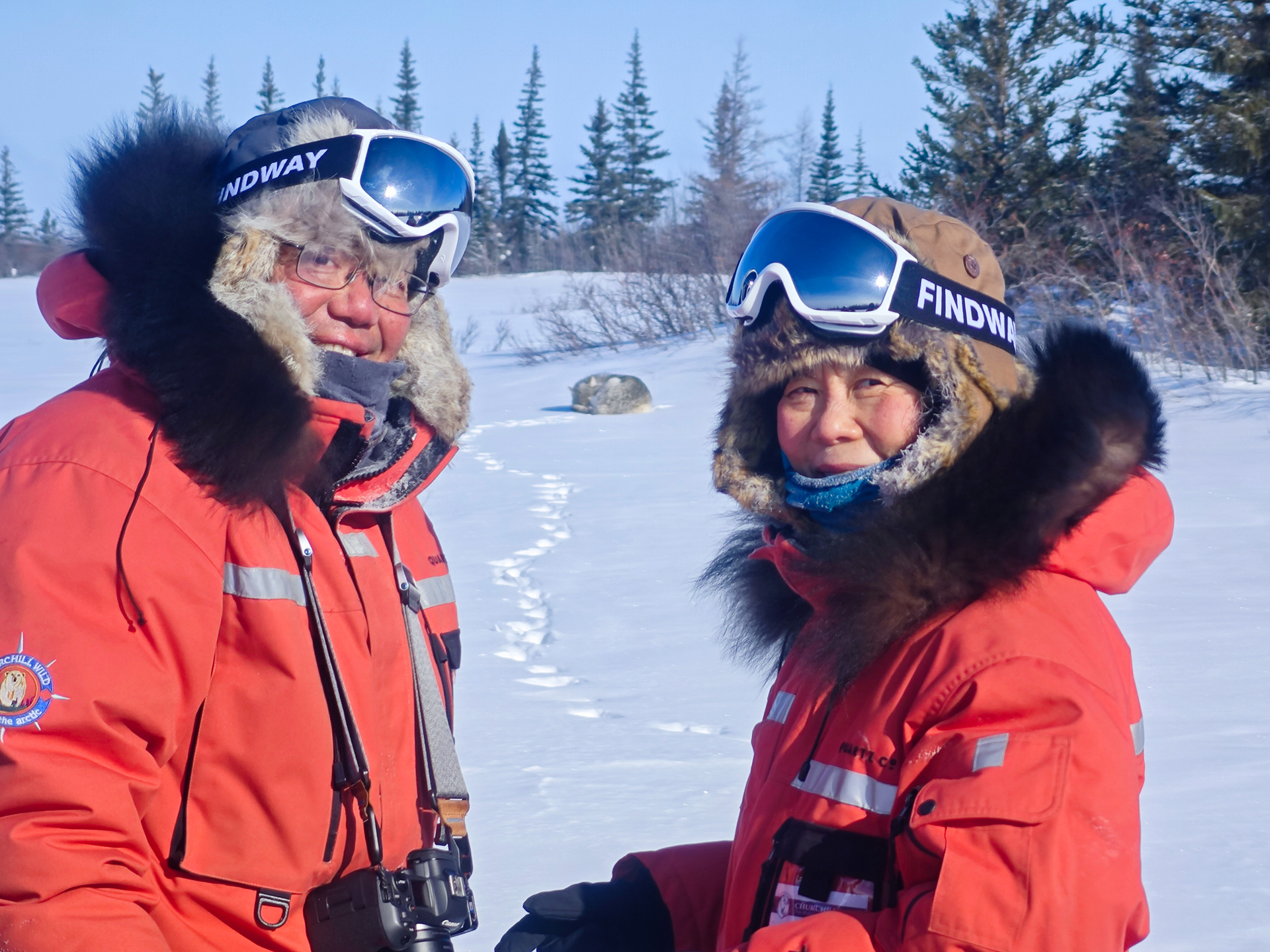
Siyu and Liu
Siyu Liu and Wei Du are a husband and wife team from Pennsylvania. They enjoy travelling around the world and exploring the wildness and nature, such as the polar regions, Africa, Alaska and the Galapagos.
WHAT IS YOUR PHOTOGRAPHY BACKGROUND?
We had limited experiences using film SLR cameras. Our wildlife photography focus started from our first trip to Antarctica.
We chose to travel with expert photographers to learn and improve our photography, such as when we visited Kenya where we learned from one of the best wildlife photographers in Africa. In a trip of searching for polar bears in the Arctic we learned from an award-wining photographer/film-maker of the BBC’s documentary series Blue Planet. A few years ago, we visited the Galapagos Islands with a National Geographic photographer. And this time with Jad, another National Geographic photographer.
WHAT INSPIRED YOU TO JOIN OUR WOLF EXPEDITION?
We planned to photograph polar bear mom and cubs in this area with Churchill Wild for several years and could make the trip due to the limited availability, then we found this trip available, and its schedule also fit with our time schedule. The description about this citizen science project helped us to decide to take this trip.
HAD YOU SEEN WOLVES IN THE WILD BEFORE?
We searched and luckily found a pack of wild wolves in Yellowstone National Park just couple of months before this trip. They were at least one mile away. It is challenging to observe and photograph the wolf pack in Yellowstone.
The pack of wolves in Yellowstone appeared moving away from people, while the pack of cloud wolves at Nanuk displayed curiosity to human and often walked toward people checking us out.
WHAT WERE THE CHALLENGES?
We were outside in open air all days at about minus 30 degrees. It is very important to follow the instructions from the trip organizers for clothing and other protective gears to avoid frost bite. The restrictions by aircraft on the weight and bag size including carryon limited the types of photography equipment we can bring with us.
WHAT GEAR DID YOU USE?
Siyu uses Canon R5 with 100-400 mm lens, and Wei shot with Nikon Z9 with 200-500 mm lens. We brought 1.4x teleconverters, but rarely used it. Each of us had a backup camera in case the prime camera malfunctioned in the extremely cold weather (did not occurred during this trip). The instructions for other protective gears were very useful and should be followed, such as 2 pairs of goggles, buff (prefer thin buff which reduces moisture buildup in goggle), 2 layers of gloves…
WHAT SURPRISED YOU ABOUT YOUR EXPERIENCE?
We enjoyed going out searching for wild animals. The variety and frequency of wild animal close encounters were very good to our surprise.
WHAT WERE SOME HIGH POINTS?
We observed a polar bear mother with two cubs at relatively close distance. The two cubs were active playing and interacting. This was totally unexpected.
One day, we observed a pack of resting wolves on ice at distance. In the late afternoon, they woke up each other by close interactions, and started walking towards us. The wolf pack circled us on ice, with curiosity and no aggression. It was a wonderful encounter.

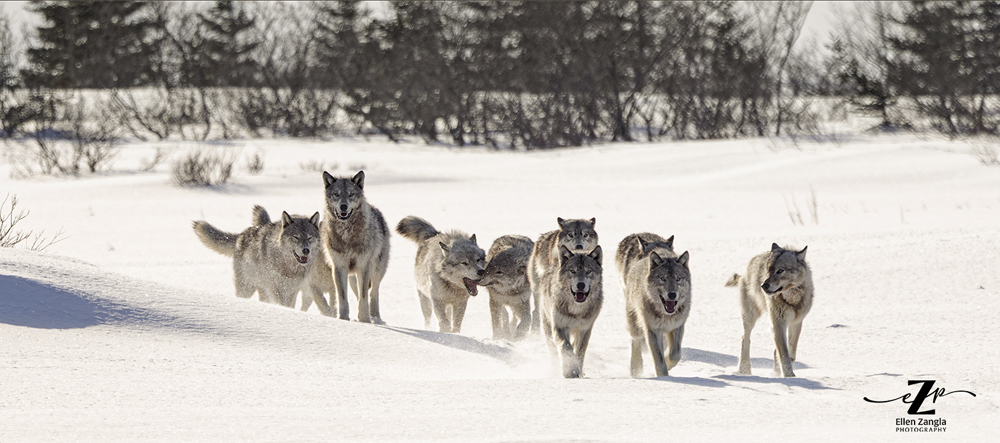









Thank you for this outstanding report. Extraordinary!!!!!!
I still hope I can come for a visit and team up with you. Cost including the flights
from Germany are unfortunately a bit to high currently for me.
But I will not give up.
Thanks again for you letting us join these wonderful expeditions through your wolf reports.
All the best,
Walter
You’re very welcome Walter. We hope you can visit us one day. We look forward to meeting you!